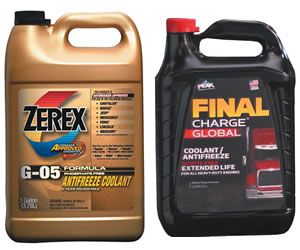
In your recent article on engine coolants (see PS October 2014 online), you wrote about replacement intervals for coolants, and Im looking for clarification. You indicated that the following heavy-duty coolants for diesels were coolants, not antifreeze: Zerex GO5, Peak Final Charge NOAT, and Detroit Diesel Power Cool Plus. You also suggested that I replace the coolant every 1,000 hours, . . . (and for little used engines) changing the coolant every five years is a more practical approach.
However, when winterizing, were supposed to replace the coolant with antifreeze, correct? So which is it, replace the coolant every five years, or flush each fall and replace with anti-freeze? By the way, my engine is a 25-horsepower Universal M-25 XPB.
Craig Deyerle
Amazing Grace, Catalina 310
Bluewater Bay, Fla.
We apologize for the confusion. The correct industry name for the glycol-based heat-transfer fluids used in engines is engine coolant. All engine coolants protect against freezing, but not all antifreeze solutions are certified for use as engine coolants. The Zerex G-05, for example, is a 50/50 glycol-based solution that will provide freeze protection to -34 degrees. Most over-the-counter coolants like the ones we tested are also 50/50 dilutions (about 48 percent glycol), the optimum mixture for corrosion protection and cooling. A more concentrated glycol solution will increase freeze protection (enough for use in Antarctica), but this is not a good operating mixture, as it will sacrifice cooling ability. A more diluted mixture sacrifices corrosion protection.
Remember that these ethylene glycol (EG) engine coolants (also sometimes labeled as antifreeze) are NOT to be used as antifreeze in potable water systems. The name change from anti-freeze to coolant was made decades ago to clarify that engine coolants should be used year-round.
Antifreeze is used specifically for winterizing fluids. These are typically (but not always) propylene-glycol (PG) products, which means that they are acceptable in potable plumbing systems. In our view, they are not a good choice for storing an engine through winter, and certainly not a good choice for an operating engine.
The term antifreeze is also used to apply to alcohol and brine-based products. We don’t recommend either of these formulations.
As for the replacement interval, so long as the glycol content is correct (see PS September 2014 online), marine engine coolant is not replaced in the winter. The required change interval varies, but is typically five years or 1,000 to 10,000 hours. The higher replacement interval generally refers to land-based engines (trucks, generators, etc.). For marine engines, we would use a more conservative 1,000-hour interval, which is closer to the suggested intervals listed in documents from Yanmar and other engine-makers.
Bottom line: Generally, we advise that you follow your engine makers service guidelines, but if you use a heavy-duty coolant like those we tested, replacing more frequently than five years/1,000 hours is wasteful, in our view. Nor do you need to use the brands that the maker recommends; some of the engine service advisories we have seen recommend products that clearly provide less protection for shorter periods of time than the top products we tested.





































